Brahms as a choral composer
Ideas for program planning
Brahms’s Deutsches Requiem (German Requiem): you only need to mention this work, and many choral singers spontaneously sigh with pleasure. It is one of those works in the magnificent canon of choral literature which everyone wants to sing at some point. At least once. But what about the many short, choral-symphonic works by Brahms, for example the Schicksalslied (Song of Destiny) or Nänie? These pieces are no less magnificent, but they present choral directors with the challenge of how to find suitable works to program with them. Tobias Brommann, Choral director at Berlin Cathedral, gives some tips.
The compositions of Johannes Brahms are rightly very popular with many choirs, even though they are amongst his more demanding works. Like no other composer, Brahms mastered what in jazz is called “voicing”, with his feel for the tessitura of the choral parts and his skill in combining these to create a marvelous sound texture. Although the motets and oratorios are often vocally challenging, they are equally rewarding to sing.
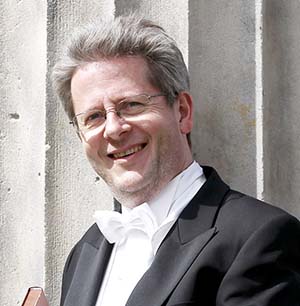
Tobias Brommann, Choral director at Berlin Cathedral
Many of the shorter sacred choral works are published in the ‘Johannes Brahms Geistliche Chormusik’ choral collection (Carus 40.179). These are also available as separate editions. Individual pieces from multi-section motets can be ordered separately, so it is possible to make a flexible compilation for a concert program or church service.
One of the easiest pieces to perform is the Geistliches Lied (Carus 40.183). The four-part mixed choir is accompanied and supported by organ, and the music is not difficult to learn. Sung at a solemn tempo, the music radiates great warmth and depth. The text by Paul Flemming is optimistic and comforting. Yet despite this, as in all works by Brahms, once again a deep melancholy pervades this work. Brahms’s music is never superficial. Even in his scherzi, you can feel that the music transports performers and listeners into the depths of the soul. It is precisely that which makes the comforting message even more convincing. The “Amen” at the end blossoms into a grand gesture, building up to an inwardly uplifting marvellous richness of sound. The highest notes in the piece are reached in a peaceful sweep (soprano g’’, tenor a flat’); these are supported by a rich harmonic foundation built on an organ pedal point, so that this is a passage which is easy to master and can be achieved by almost all amateur choirs. A recommendation as a repertoire piece for all choirs!
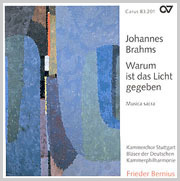
From:
Johannes Brahms. Warum ist das Licht gegeben. Musica sacra
Kammerchor Stuttgart
Bläser der Deutschen Kammerphilharmonie
Frieder Bernius
CD Carus 83.201
The best-known unaccompanied choral works by Brahms include the “great” motets, first and foremost Warum ist das Licht gegeben (Carus 40.120/10). In his earlier Missa canonica Brahms ‘tests’ the melodic intricacies of the canon theme used. Here, we have to admit that he had not yet fully reached his later maturity. In the Agnus Dei, for example, as a precursor of the Warum canon, a slightly harsh sound results from a somewhat awkward use of the vocal ranges. In the later motet the choral parts are written with considerably more skill. Through the denser style of setting and the more comfortable easy-to-sing ranges, the tonal sound is perfectly balanced. But of course the canon theme of the first movement alone is the province of more ambitious choirs. The later movements are harmonically easier to master, but the six-part writing also contains some challenges. However, the concluding four-part chorale Mit Fried und Freud ich fahr dahin can be easily performed by a choir familiar with Bach chorales, and can be sung as a stand-alone piece.
Amongst the works for larger forces there are some which are sadly not often performed. Like Mendelssohn’s chorale cantatas there is the difficulty of categorizing them. A large Romantic orchestra for a cantata or short oratorio of five to ten minutes’ duration must be programmed as part of a concert – a work with such a large scoring will almost certainly not be included in a church service. And it is precisely these choral works which undoubtedly deserve a place in the concert hall.
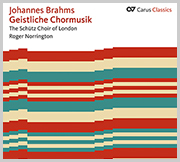
From:
Johannes Brahms. Geistliche Chormusik
The Schütz Choir of London
Roger Norrington
CD Carus 83.332
Hot off the press is the music for Nänie (Carus 10.398). Similar to the Deutsches Requiem, the work captivates through a wonderful sonority as deserving of the attribute “depth” as many other compositions by Brahms. Because it is scored for just 4 voice parts throughout, it presents few challenges for experienced choirs, especially as the occasional surprising modulations and sudden shifts will easily be learned by choral singers familiar with Brahms’s writing. A rewarding piece!
The question remains in which context such a piece might be performed. It deals with the theme of death from a secular perspective, but could be included in a church concert as a counterpart to a Requiem – perhaps even juxtaposed with Brahms’s Deutsches Requiem. Or Nänie deserves a place as part of a concert with other Romantic choral and orchestral music.
As in Nänie, the original scoring of the Schicksalslied is for a large Romantic orchestra, with all its wonderful characteristic sounds, but setting that aside, it is only 15 minutes in duration. In return, this work, scored throughout for four-part choir, rewards with the wealth of sound colors that Brahms liked to use, and there are echoes of the Requiem and the opening of his first symphony, with the memorable use of the timpani.
In these times in particular, the question of performability is even more important than in normal times. There is a great deal to be said for creating versions which reduce the large forces to a minimum. Here, the versions for chamber orchestra of the Deutsches Requiem (for chamber orchestra: Carus 27.055/50 / for two pianos, four hands: Carus 23.006/03) and the Schicksalslied (Carus 10.399/50) are worth special mention. With no or very few soloists, these pieces are also suitable for choirs with limited budgets or smaller performance spaces.


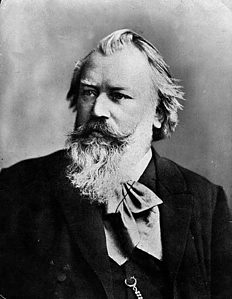
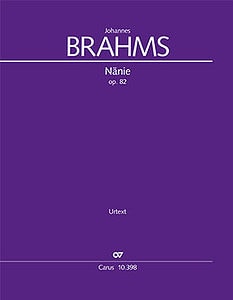 Brahms’ elegy Nänie op. 82, based on the poem by Friedrich von Schiller, was composed in 1880/81. In contrast with the poem, Brahms’ Nänie ends full of hope: after earthly decline, beauty can live on in art. As in his Deutsches Requiem op. 45, in Nänie Brahms creates a musical connection between mourning and consolation in an incomparable way.
Brahms’ elegy Nänie op. 82, based on the poem by Friedrich von Schiller, was composed in 1880/81. In contrast with the poem, Brahms’ Nänie ends full of hope: after earthly decline, beauty can live on in art. As in his Deutsches Requiem op. 45, in Nänie Brahms creates a musical connection between mourning and consolation in an incomparable way.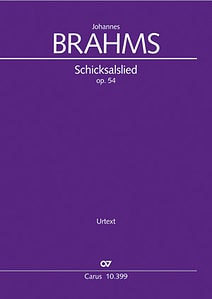 With the Schicksalslied / Song of Destiny Brahms created a very personal interpretation on the theme of fate in a timeless piece of music that will not fail to impress in concert hall or church.
With the Schicksalslied / Song of Destiny Brahms created a very personal interpretation on the theme of fate in a timeless piece of music that will not fail to impress in concert hall or church.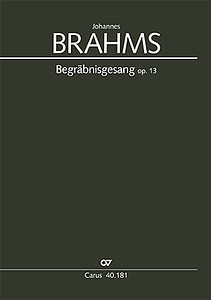
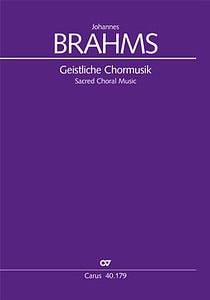 All the sacred motets by Johannes Brahms are published together here in one anthology: from the early
All the sacred motets by Johannes Brahms are published together here in one anthology: from the early

Clarification/amendment of my previous comment:
I am interested to know if anyone has considered adding harp to the chamber arrangement of Johannes Brahms Ein deutsches Requiem, Arrangement for chamber orchestra (Linckelmann) op. 45.
I would love to hear feedback from your experience in presenting this arrangement in concert. I conduct a 35-voice choir. Thank you in advance.
MW-G
I wonder if anyone has considered adding harp to this chamber ensemble?
I would love to hear feedback from your experience. Thank you in advance.
MW-G